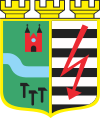Zawiercie
| Zawiercie | ||
|---|---|---|
|
||
| Coordinates: 50°30′N 19°25′E / 50.500°N 19.417°E | ||
| Country |
|
|
| Voivodeship | Silesian | |
| County | Zawiercie County | |
| Gmina | Zawiercie (urban gmina) | |
| Government | ||
| • Mayor | Witold Grim | |
| Area | ||
| • Total | 85.24 km2 (32.91 sq mi) | |
| Highest elevation | 400 m (1,300 ft) | |
| Lowest elevation | 300 m (1,000 ft) | |
| Population (2012) | ||
| • Total | 51,862 | |
| • Density | 610/km2 (1,600/sq mi) | |
| Time zone | CET (UTC+1) | |
| • Summer (DST) | CEST (UTC+2) | |
| Postal code | 42-400 to 42-431 | |
| Area code(s) | (+48)32 | |
| Car plates | SZA | |
| Website | http://www.zawiercie.eu | |
Zawiercie [zaˈvʲɛrt͡ɕɛ] is a city in the Silesian Voivodeship of southern Poland with 51,880 inhabitants (2011). It is situated in the near the source of the Warta River. The city has also historically been known by the names Zaveyurchy, Zavertse, Zavirtcha, and Zavyerche. The town lies near the historical region of Silesia, but belongs to Lesser Poland. In 1945, it was made a part of the Katowice Voivodeship. Zawiercie is home to a sports club Warta Zawiercie, established in 1921.
Zawiercie, even though currently associated with Silesia, belongs to Lesser Poland. The town lies near the source of the Warta river, and its name probably comes from the location. The inhabitants of the ancient village of Kromołów, to reach another village located on the other side of the river, would go behind the Warta, or in Polish - za Wartę. From the perspective of Kromołów, Zawiercie is located behind the Warta. The town is a gateway to the , where several castles, which used to defend western border of Lesser Poland, are located.
Zawiercie has the area of 85 square kilometers, and until 1945, the town was administratively tied with Lesser Poland’s Kielce. It is located along the Warsaw–Vienna railway, and is a road hub, on the National Road Nr. 78.
First mention of the village of Kromołów (now a district of Zawiercie) comes from 1193. In the 14th century, the village was located in western Lesser Poland, along a merchant road from Kraków to Poznań. In 1431, Prince Bolko IV of Opole allowed a man named Mikołaj Czenar to open an inn here, and in his document, the name Zawiercie is mentioned for the first time. In the 15th century, the area became the early center of iron manufacturing, but despite this Zawiercie remained for centuries a small village. Until the 19th century, it was divided into Zawiercie Małe (Small Zawiercie) and Zawiercie Duże (Big Zawiercie), both administratively belonged to the gmina of Kromołów .
...
Wikipedia


